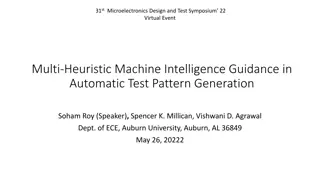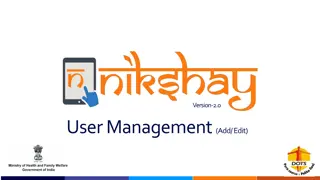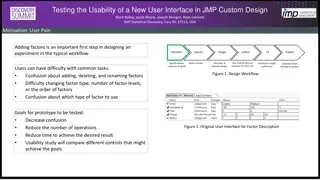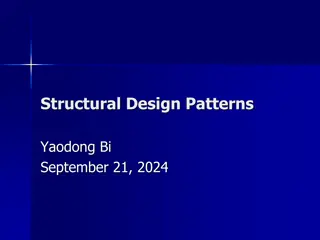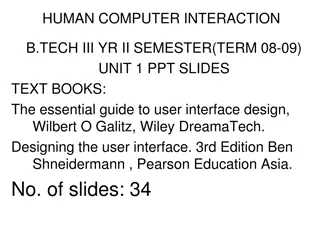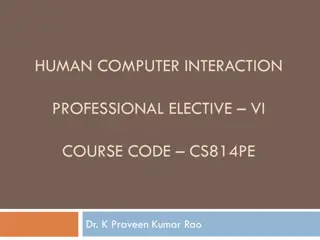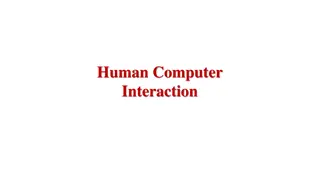Understanding Heuristic Evaluation in User Interface Design
Heuristic evaluation is an analytical method where experts evaluate interfaces based on usability principles. This evaluation helps in identifying potential design issues that may impact user satisfaction. The process involves a small group of evaluators reviewing the interface against a set of recognized usability principles known as heuristics. The findings are consolidated into a report to improve the user experience. Examples of heuristics include the visibility of system status, match with the real world, user control, consistency, error prevention, and more. The number of evaluators affects the number of usability problems identified in an evaluation.
Download Presentation

Please find below an Image/Link to download the presentation.
The content on the website is provided AS IS for your information and personal use only. It may not be sold, licensed, or shared on other websites without obtaining consent from the author. Download presentation by click this link. If you encounter any issues during the download, it is possible that the publisher has removed the file from their server.
E N D
Presentation Transcript
Heuristic Evaluation Image Source: https://pxhere.com/de/photo/1436411 The following content is licensed under a Creative Commons Attribution 4.0 International license (CC BY-SA 4.0) Valentin Schwind 1
Learning Goals Understand heuristic evaluation as analytical evaluation method Understand when and how heuristic evaluations can be used Learn strengths and weaknesses Heuristic Evaluation Valentin Schwind 2
Heuristic Evaluation A small set of evaluators examines the interface and judge its compliance with recognized usability principles (the "heuristics"). Goal: identifying any problems associated with the design of user interface Main question: Is the interface compatible with the intended users' needs and preferences Nielsen, J., and Molich, R. (1990). Heuristic evaluation of user interfaces, Proc. ACM CHI'90 Conf. (Seattle, WA, 1 5 April), 249 256 Nielsen, J. 1992. Finding usability problems through heuristic evaluation. Proceedings ACM CHI'92 Conference (Monterey, CA, May 3-7), 373-380./ Heuristic Evaluation Valentin Schwind 3
Heuristic Evaluation A small group of reviewers/experts examine the interface and judge its compliance with recognized usability principles (the heuristics ) Either just by inspection or by scenario-based walkthrough Critical issues list, weighted by severity grade Opinions of evaluators are consolidated into one report Implicit assumptions There is a fixed list of desirable properties of user interfaces (the heuristics ) These heuristics can be checked by the experts with a clear and defined result Heuristic Evaluation Valentin Schwind 4
Example: Checklist Deniese Pierotti, Xerox Corporation, From https://uxmanager.net/heuristics/xerox-13-usability-heuristics Heuristic Evaluation Valentin Schwind 5
Number of Evaluators The number of usability problems found in a heuristic evaluation: ?????????????(?) = ?(1 1 ??) Nielsen, J., & Landauer, T. K. (1993, May). A mathematical model of the finding of usability problems. In Proceedings of the INTERACT'93 and CHI'93 conference on Human factors in computing systems (pp. 206-213). Heuristic Evaluation Valentin Schwind 6
Nielsens Heuristics 1. Visibility of system status 2. Match between system and the real world 3. User control and freedom 4. Consistency and standards 5. Error prevention 6. Recognition rather than recall 7. Flexibility and efficiency of use 8. Aesthetic and minimalist design 9. Help users recognize, diagnose, and recover from errors 10.Help and documentation Nielsen, Jakob (1994). Usability Engineering. San Diego: Academic Press. pp. 115 148. ISBN 0-12-518406-9. Heuristic Evaluation Valentin Schwind 7
Example Removing files Dismount drive Images from Sarah Diefenbach, UX Evaluation, 2017 Heuristic Evaluation Valentin Schwind 8
Weinschenks & Barkers Heuristics 1. User Control 2. Human Limitations 3. Modal Integrity 4. Accommodation 5. Linguistic Clarity 6. Aesthetic Integrity 7. Simplicity 8. Predictability 9. Interpretation 10.Accuracy 11.Technical Clarity 12.Flexibility 13.Fulfillment 14.Cultural Propriety 15.Suitable Tempo 16.Consistency 17.User Support 18.Precision 19.Forgiveness 20.Responsiveness Weinschenk, S and Barker, D. (2000) Designing Effective Speech Interfaces. Wiley. Heuristic Evaluation Valentin Schwind 9
Cognitive Engineering Principles 1. Automate unwanted workload 2. Reduce uncertainty 3. Fuse data 4. Present new information with meaningful aids to interpretation 5. Use names that are conceptually related to function 6. Group data in consistently meaningful ways 7. Limit data-driven tasks 8. Include in the displays only that information needed by the user at a given time 9. Provide multiple coding of data when appropriate 10.Practice judicious redundancy Heuristic Evaluation Valentin Schwind 10
Advantages and Disadvantages Advantages Quick, cheap, easy evaluation of early UI design Disadvantages Heuristic evaluation relies very much on creativity and experience of the evaluators Available knowledge about decision only available in the heads of the experts Usability checklists and inspections can produce rapid feedback, but may call attention to problems that are infrequent or atypical in real worlds use. [1] [1] Rosson, M. B., Carroll, J. M., & Hill, N. (2002). Usability engineering: scenario-based development of human- computer interaction. Morgan Kaufmann. Heuristic Evaluation Valentin Schwind 11
References Nielsen, J., and Molich, R. (1990). Heuristic evaluation of user interfaces, Proc. ACM CHI'90 Conf. (Seattle, WA, 1 5 April), 249 256 Nielsen, J. 1992. Finding usability problems through heuristic evaluation. Proceedings ACM CHI'92 Conference (Monterey, CA, May 3-7), 373-380. Nielsen, Jakob (1994). Usability Engineering. San Diego: Academic Press. pp. 115 148. ISBN 0-12- 518406-9. https://www.nngroup.com/ Heuristic Evaluation Valentin Schwind 12


